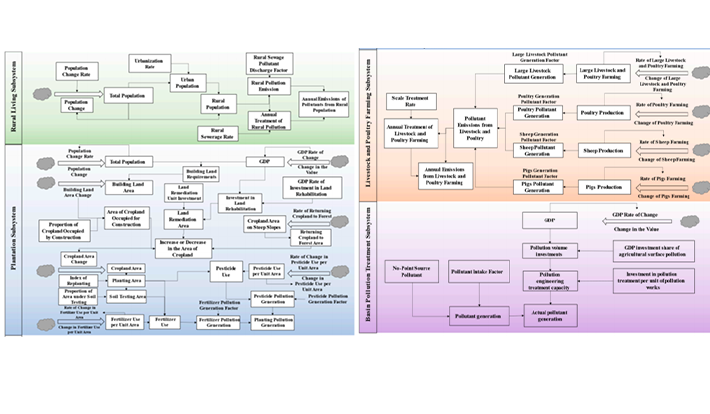Study on Non-Point Source Pollution Prevention and Control System in Nansi Lake Basin Based on System Dynamics Approach
发表期刊:Sustainability
分区:SCI三区
影响因子:3.3
Agriculture, as an important activity on which human beings depend for their livelihood, brings serious environmental problems while meeting the needs of human survival, among which agricultural non-point source (NPS) pollution is one of the most urgent environmental problems. This study quantitatively assessed the loading characteristics spatial and temporal evolution patterns of two agricultural NPS pollutants, chemical oxygen demand (COD) and ammonia nitrogen (NH3-N), from 2010 to 2020 in the Nansi Lake Basin as an example, and constructed a system dynamics (SD) simulation model to simulate and analyze agricultural NPS pollution under different development and treatment scenarios, based on an investigation of the regional prevention and control strategy of agricultural NPS pollution and the technological system. The results show that the current status of agricultural NPS pollution load in the Nansi Lake Basin is poor, and the level of pollution load is high, showing obvious geographical differences. In terms of temporal changes, the pollution loads of the two pollutants showed a decreasing trend from 2010 to 2020, among which the pollution load of NH3-N showed the largest change. Spatially, the spatial distribution of each type of pollutant has some similarities, with smaller pollution loads in Jining and Zaozhuang and relatively larger pollution loads in Heze and Ningyang. The main source of COD pollution in the Nansi Lake Basin is rural life, with an emission proportion of 52.85%, and the main sources of NH3-N pollution from agricultural NPS pollution in the area are rural life and livestock and poultry farming, with emission proportions of 47.55% and 35.36%, respectively. Under the status quo continuum scenario, the pollution load values for COD are consistently higher than those for NH3-N, so the relative impact of COD is greater. In this study, the principles and methods of SD in system science are adopted to deal with the agricultural NPS pollution of Nansi Lake Basin, and the evolution of its behavioral characteristics are simulated, forecasted, and predicted, and policy experiments are conducted, with a view to providing references for the prevention and control of agricultural NPS pollution in Nansi Lake Basin and further research.


